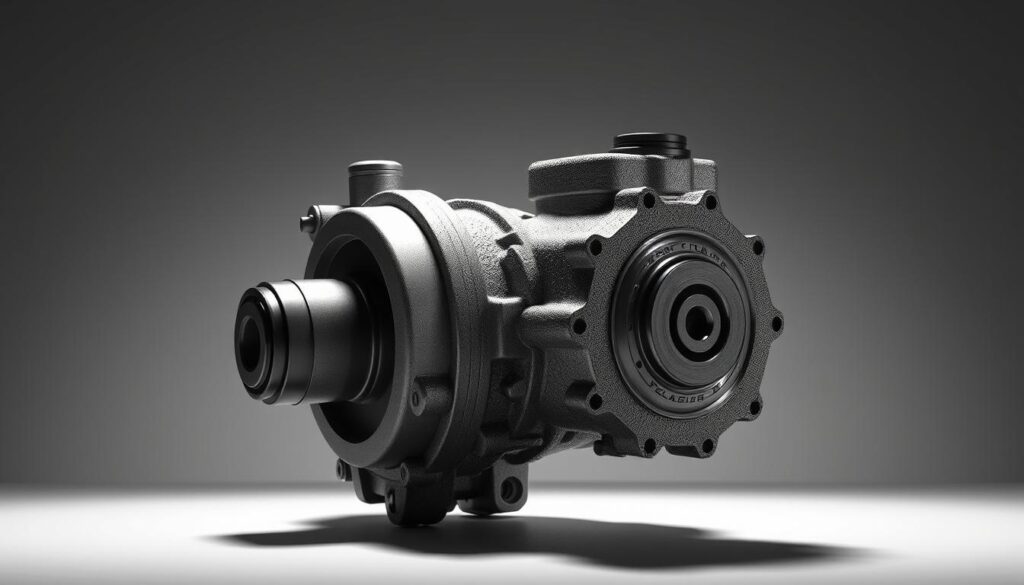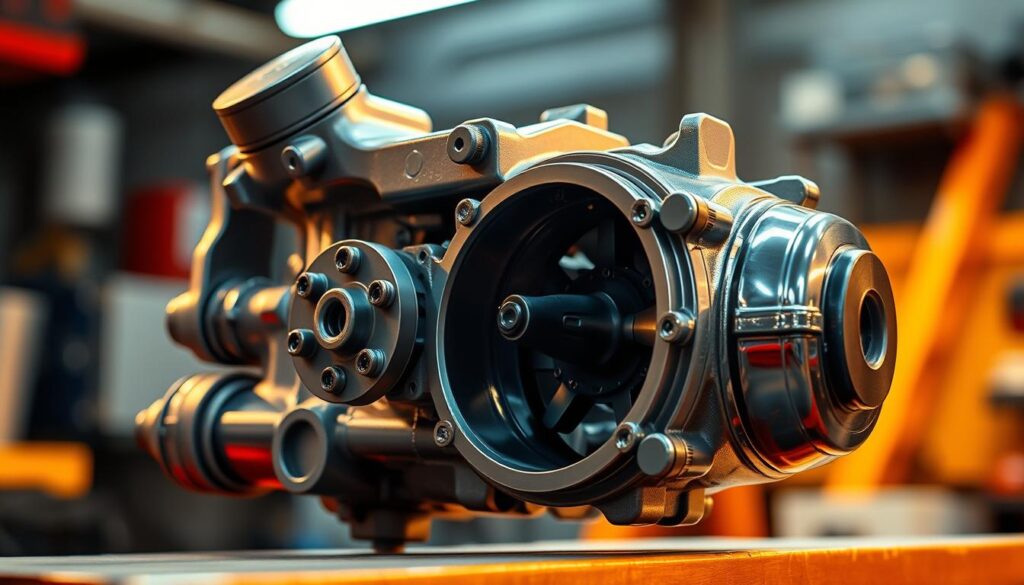Surprising fact: about 1 in 5 truck owners report a groan or whine on cold mornings when they turn the wheel — and it often fades as the engine warms up.
We hear you — that fade-out pattern usually points to thick, cold fluid or tiny air bubbles rather than instant mechanical failure. We’ll walk through what the sound and feel tell you first, so you can avoid a costly repair by starting with the simple checks.
We explain how temperature, low or aerated fluid, and a tired pump can make assist cut in and out. You’ll learn why a groan differs from a high-pitched whine, and what each sign suggests about the pump, hoses, or steering gear.
Key Takeaways
- Cold-morning groans often mean thick fluid or aeration — check level and condition first.
- High-pitched whines can point to cavitation or trapped air at the pump.
- Load-related sounds (loud at stop, quieter while rolling) hint at pressure or flow issues.
- Turn-direction differences can indicate gear valves or hose routing under side-load.
- Start with simple driveway checks before booking full access to a shop for a pressure test.
Q&A: What does your Tahoe’s steering noise tell you right now?
When a truck groans at startup but quiets as it warms, the cause is often circulatory rather than catastrophic.
Cold-morning groan that fades as the truck warms up
Likely cause: thick, cold steering fluid or small air bubbles that make the p/s pump work harder. Check level and look for foam at the cap.
If the sound drops as temperature rises, a proper bleed and a correct-spec refill often fixes the problem without parts.
Noise only on left turns but smooth feel on the steering wheel
This often points to flow paths inside the gear or a hose that resonates on one side. Swap the front tires and inspect intermediate shaft mounts for play.
No noise when wheels are off the ground, loud when the truck is on the pavement
That pattern shows a load-dependent issue. Pressure spikes under load can make a marginal gear or pump howl. Road load reproduces the symptom; jack tests may not.
Strange low-speed feel from the variable steering effort system
The system uses a column sensor and a connector at the pump. Cleaning the posts and reseating the plug often restores normal assist and stops odd surges.
- Quick driveway test: turn lock-to-lock with the cap off and watch for foam.
- Note whether the sound changes at full turns — that narrows the cause.
- If fluid aeration looks likely, bleed the circuit before replacing parts.
Causes of intermittent power steering noise in Chevy Tahoe

Cold start grumbles often point to flow limits rather than instant failure.
Fluid issues: low level, aeration, and cold-viscosity groan
Low reservoir or foamy fluid draws air at the inlet. That foam compresses and makes the groan until bubbles clear.
Thick steering fluid at low temps resists flow. The pump strains, assist dips, and the sound fades as the fluid warms.
Pump and inlet O-ring: cavitation and whine
A failing power steering pump or a hardened inlet O-ring can let suction air slip past without visible leaks. Cavitation then forms tiny vapor bubbles that collapse and wear the vanes.
Gear and load-related sounds during turns
Steering gear internals can complain only on certain turns. If the sound stops with the wheel off the ground, suspect load-dependent pressure or valve issues.
Electrical inputs: sensor and connector effects
The variable-assist system relies on a steering position sensor and pump posts. Corrosion or a loose connector can change assist and make the drive feel odd.
Check hoses, look for foam, then bleed the circuit before replacing parts.
| Cause | Typical sign | DIY check | Next step |
|---|---|---|---|
| Low fluid / aeration | Foam at cap, morning groan | Inspect reservoir, cap off, lock-to-lock | Bleed and top with correct fluid |
| Pump cavitation / O-ring | High-pitched whine, wear particles | Shine light through fluid, check clamps | Pressure test; replace pump or O-ring |
| Gear load issue | Noise only during turns, directional | Lift front wheels, road-test | Mechanic: inspect gear or valves |
Why do GM power steering pumps whine, and what are the fixes?

When a sharp whine shows up at low rpm, cavitation and air ingestion are often the real culprits—not worn bearings.
Common causes: tiny air leaks at the suction side, a hardened inlet O-ring, or poor hose routing that starves the pump at idle. A kinked return or collapsed inner liner makes the pump pull harder and whine during slow turns.
Use the correct power steering fluid. Wrong fluid foams or thins and makes the problem worse. Owners have also fixed odd feel by cleaning the steering position sensor connector at the pump base.
Quick fixes and when to call a pro
- Bleed the circuit: wheels off, engine off, lock-to-lock 15–20 times; top off; then run engine and repeat slowly.
- If the whine returns, replace the inlet O-ring and check the pump shaft seal.
- Clean the sensor and pump-bottom connector to stabilize assist from the module.
| Symptom | Likely cause | Next step |
|---|---|---|
| Whine at idle | Cavitation / air at inlet | Bleed, inspect O-ring |
| Directional howl on turns | Hose routing or valve load | Check hoses, road-test |
| Persistent high-pitch with dark fluid | Vane or housing wear | Mechanic: pressure/flow test, pump or steering gear |
Conclusion
In short: most start-up groans or whines give you a clue — their timing and when they stop tell the story. Check level, watch for foam, and use the correct power steering fluid to quiet that early-morning noise.
Work through a simple checklist: inspect the steering pump, seals, and lines. A seal or inlet O-ring and a careful bleed often calms the pump and protects the steering gear. Note which turns trigger the sound and whether the steering wheel feels heavy.
If the issue stays after those steps, clean the sensor plug and retest. For sudden loss of assist or jerky steering wheel movement, park and call a mechanic. If you need shop data, an access memberjoined pressure/flow check removes guesswork and points to the right repair.
FAQ
Cold-morning groan that fades as the truck warms up — what’s causing it?
That early-morning groan often points to low fluid level or thicker fluid at low temperatures. The pump works harder when the oil is cold, so it can groan until the fluid warms and thins. Check the reservoir, top with the manufacturer‑approved fluid, and inspect for leaks. If level and fluid are fine, the pump or inlet seal may be cavitating and should be inspected.
There’s noise only on left turns but the wheel feels smooth — is that serious?
A directional noise with a smooth wheel often means the steering gear or a hose is under different load on one side. It can be a worn gear, a binding link, or return hose collapse under pressure. Have tie rods, pitman/idler arms, and the gear box checked. If bearings or a rack mount are worn, they can make noise without harsh steering feedback.
The sound disappears when the wheels are lifted off the ground — what does that tell us?
If the noise vanishes with the wheels off the pavement, the issue is load-related—something in the steering circuit or suspension that only shows under weight. Look at the pump, steering gear, and hoses for collapse or restriction. Also confirm belt tension and condition; a slipping belt can change behavior under load.
Low-speed feel is odd on models with variable assist — could an electrical part be to blame?
Yes. Variable-assist systems rely on a steering angle or torque sensor and an electrical input to modulate assist. A bad connector or sensor reading can change assistance and produce unusual sounds. Scan for codes, clean the pump connector, and inspect wiring before replacing major components.
How do fluid issues like aeration or cold viscosity create groans and whines?
Aeration—air mixed into the fluid—causes cavitation and a gritty or whining sound. Thick, cold fluid increases pump load and can groan. Both reduce lubrication and increase wear. Bleed the system correctly, replace old fluid with the right spec, and make sure suction lines and reservoir caps seal properly.
Why do GM steering pumps cavitate or whine more than others?
Some GM pumps are sensitive to inlet restrictions and improper hose routing. A collapsed or kinked suction hose, a damaged inlet O‑ring, or a weak belt can let the pump starve and cavitate. Proper hose routing, fresh O‑rings, and an inspection of the pump inlet usually cure recurring whine.
What quick DIY fixes should we try before visiting a shop?
Start simple—check fluid level, top with the correct fluid, and tighten or replace the drive belt if it’s glazed. Bleed the system to remove air. Inspect hoses, fittings, and the pump connector for leaks or corrosion. If the problem persists after these steps, get a professional diagnosis.
When is it time to see a mechanic instead of DIYing?
See a pro when you find metal flakes in the fluid, persistent cavitation after bleeding, unusual steering play, or electrical codes related to the steering sensor. Also visit a shop for pump replacement, gear overhaul, or when specialized tools (pressure gauge, scan tool) are needed.
Can a bad inlet O-ring or hose routing damage the steering pump permanently?
Yes. A leaking or collapsed inlet O‑ring lets air into the suction side and causes cavitation that rapidly wears pump internals. Improper hose routing that allows kinks or heat exposure shortens component life. Fix seals and routing promptly to avoid a full pump failure.
What should be checked during a professional inspection for these symptoms?
A shop will check fluid condition and level, belt tension, hose integrity, pump inlet and O‑ring, steering gear condition, sensor inputs, and electrical connectors. They’ll also perform a pressure test and scan for codes to pinpoint variable-assist faults.
Recent Posts
If youre staring up at a drooping piece of fabric, dont fret—learning **how to fix car interior roof** sagging is surprisingly simple and a fantastic way to refresh your ride without a hefty repair...
Don't let the winter chill compromise your little one's comfort! Discover the must-know tips for keeping your car seat cozy and safe all season long.


